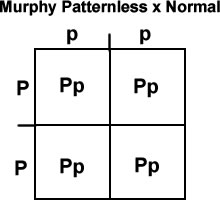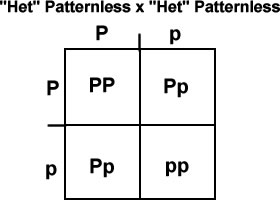Recessive
Recessive
A gene which is recessive only shows their effect if there are two copies of the gene in the pair of alleles from their parents. When using a Punnent Square, recessive traits are shown by using a lower case letter. An example of a recessive trait (Murphy Patternless) crossed with a Normal can be seen on the right.
When dealing with recessive traits, it takes two generations to show the trait. In our example, all of the F1, or First Generation babies will be heterozygous for the trait. To achieve a gecko who is homozygous for Murphy Patternless, the easiest route would be to breed the hatchlings to each other. There would be a 25% chance of creating a Murphy Patternless Leopard Gecko in the F2, or Second Generation. The other possibilities are 25% Normal, and 50% Normal heterozygous or het for Murphy Patternless.
Currently there are a few recessive traits in Leopard Geckos. They can be seen below:
--MK Geckos 16:07, 18 September 2007 (EDT)

